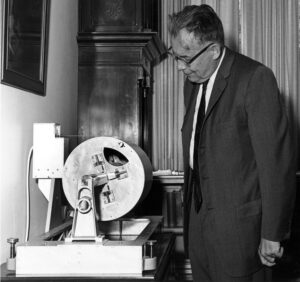
Established in 2005, the Charles F. Richter Early-Career Award is part of SSA’s longstanding commitment to supporting the next generation of seismologists. The award honors outstanding contributions to the goals of the Society by a member early in her or his career and provides recipients with a $3,000 cash award from the William B. Joyner Memorial Fund.
Award Criteria
The Richter Award honors outstanding contributions to the goals of the Society by a member early in their career and is given no more than once a year. An awardee’s contributions should advance
seismology and/or the understanding of earthquakes for the benefit of society and reflect the core values of SSA.
Read about past recipients here.
Award Eligibility
Nominees must satisfy the following criteria: 1) they must be regular or honorary members of the Society in good standing and 2) their most recent academic degree must have been awarded no more than six years prior to the year in which the award is given.*
* Family or medical leave, if provided by the candidate’s institution and taken by the nominee during this six-year period, can extend the six-year period.
No individual who is a member, member-elect or officer of the Board of Directors at the time of the nomination deadline shall be eligible for nomination.
Nomination Procedure
The chief nominator must be an SSA member who is eligible to submit a nomination. Any member of SSA may nominate a candidate for this award, with the exception of members of the Richter subcommittee, SSA Board of Directors and SSA Award Encouragement Committee.
The nomination package should contain: 1) a letter of nomination no more than two pages long that establishes the nominee’s eligibility and summarizes the nominee’s significant accomplishments, 2) a curriculum vitae including bibliography, 3) two to four supporting letters no more than two pages long, including at least two letters from individuals who are not currently employed at the nominee’s current institution nor the institution from which the nominee received their most recent degree. Any unsuccessful nomination may be considered again in the following year’s award cycle without resubmission of the nomination package if the nominee still meets eligibility requirements and their reconsideration is requested by a nominator before 30 September of that year. To be reconsidered in subsequent years (beyond the year immediately following the original nomination), a new nomination package must be submitted. The Executive Director will contact nominators via email prior to 30 September to confirm willingness for reconsideration of a package for a second year.
A signed nominator disclosure form submitted by the chief nominator must be included with every submission. Click here to complete the Ethics Disclosure Form for Nominators.
Awardee Selection
The Richter Subcommittee will seek one qualified recipient for the award to recommend to the Board. If the subcommittee feels there is no qualified recipient, they will recommend that no award be conferred that year. If the subcommittee cannot decide between two
nominees, the subcommittee may forward two names to the Board for vote. After making its selection, the Subcommittee should write a letter to the Board containing: 1) a list of all nominees, 2) the proposed recipient, 3) some text briefly explaining the nominee’s characteristics that justify the subcommittee’s decision 4) optionally, if deemed necessary, some text listing in general terms, without naming names, the reason the proposed recipient was preferable to the other candidates and 5) a brief description of the selection process. The subcommittee will provide this letter to the HC Chair who will forward the letter and nomination package for the proposed recipient to the Executive Director. The Board will vote up or down on the proposed recipient.
The HC does not review the Subcommittee decisions, except in the case that two nominations are forwarded for vote. The HC may review the procedures and/or act in an advisory capacity to the Subcommittee. The HC, the SSA Board and staff should keep names of nominees and nomination materials private.
Subcommittee Membership
Six persons, including the chair, serve on this subcommittee. All subcommittee members must be SSA members. One member of the subcommittee, preferably the chair, should also be a member of the HC. Subcommittee membership may include no more than two past Richter Award recipients and would ideally include a mix of mid to late career members. No person eligible for the Richter Award may sit on the subcommittee. Normal term of service is two years, with the chair serving for two years.
Deadline and More Details
Nominations for all SSA awards should be sent to the SSA Secretary by 30 September, midnight PST. Electronic submissions should be e-mailed in .TXT, .PDF or .DOC files to awards@seismosoc.org.
For more information, see the SSA Honors Program guide.
2026 Charles F. Richter Early-Career Award

Kevin Milner is the recipient of the 2026 Charles F. Richter Early Career Award for his wide-ranging, globally adopted research that has become central to seismic hazard analysis modeling.
Milner, a research geophysicist at the U.S. Geological Survey’s Geologic Hazards Science Center, was honored for his rare combination of computer science expertise, geophysical insight and his exceptional record of innovation and collaboration.
Milner was recruited as a research programmer at the Statewide California Earthquake Center after completing his bachelor’s degree in computer science in 2007. During his time at SCEC, Milner completed his master’s and Ph.D. degrees in geophysics as he was lead developer of OpenSHA, an open-source computations platform now used for seismic hazard analysis modeling around the world.
His research contributions—and numerous publications—related to seismic hazard analysis include advanced computational infrastructure open-source tool development, testing earthquake forecasting and early warning systems, quantification of epistemic uncertainty in hazard and risk models, and development of the National Seismic Hazard Model in the U.S. and New Zealand.
